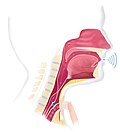Voice therapy
Voice therapy (also known as voice training) is the assessment and treatment of voice disorders. It involves therapeutic exercises and behavioral techniques designed to improve the voice's quality, pitch, volume, and endurance. Voice therapy is often recommended for individuals who have experienced voice problems due to misuse or overuse of the voice, surgery affecting the vocal cords, or conditions such as vocal fold nodules, vocal fold paralysis, or dysphonia. The goal of voice therapy is to rehabilitate the patient's voice to a level where it is functional for daily communication, professional use, or performance.
Indications[edit]
Voice therapy is indicated for a variety of conditions, including but not limited to:
- Vocal fold nodules and polyps
- Vocal fold paralysis or paresis
- Dysphonia, including muscle tension dysphonia
- Laryngitis, both acute and chronic
- Voice changes associated with aging, known as presbyphonia
- Voice disorders related to gastroesophageal reflux disease (GERD)
- Voice impact from neurological conditions, such as Parkinson's disease or multiple sclerosis
Assessment[edit]
Before starting voice therapy, a thorough assessment is usually conducted by a speech-language pathologist (SLP) specializing in voice disorders. This assessment may include:
- Patient history
- Visual examination of the vocal folds, often using laryngoscopy or stroboscopy
- Voice quality analysis using acoustic measurements
- Aerodynamic measurements, assessing airflow and pressure during phonation
- Patient-reported outcome measures
Techniques[edit]
Voice therapy techniques vary depending on the individual's specific needs but may include:
- Vocal hygiene education, which involves teaching the patient how to care for their voice (e.g., staying hydrated, avoiding shouting)
- Breath support and control exercises
- Phonation exercises, focusing on efficient vocal fold vibration
- Resonance training
- Pitch and loudness adjustments
- Relaxation techniques to reduce muscle tension
- Speech therapy exercises to modify speaking behaviors that contribute to voice strain
Outcomes[edit]
The effectiveness of voice therapy can depend on several factors, including the type and severity of the voice disorder, the patient's adherence to the therapy program, and the presence of any underlying medical conditions. Many patients experience significant improvements in voice quality, vocal endurance, and overall vocal function following voice therapy.
See Also[edit]
References[edit]
<references/>
-
Sagittal view of the mouth
-
Voice prosthesis device
-
Vocal cord polyp
-
Flexible endoscope
Ad. Transform your life with W8MD's Budget GLP-1 injections from $75


W8MD offers a medical weight loss program to lose weight in Philadelphia. Our physician-supervised medical weight loss provides:
- Weight loss injections in NYC (generic and brand names):
- Zepbound / Mounjaro, Wegovy / Ozempic, Saxenda
- Most insurances accepted or discounted self-pay rates. We will obtain insurance prior authorizations if needed.
- Generic GLP1 weight loss injections from $75 for the starting dose.
- Also offer prescription weight loss medications including Phentermine, Qsymia, Diethylpropion, Contrave etc.
NYC weight loss doctor appointmentsNYC weight loss doctor appointments
Start your NYC weight loss journey today at our NYC medical weight loss and Philadelphia medical weight loss clinics.
- Call 718-946-5500 to lose weight in NYC or for medical weight loss in Philadelphia 215-676-2334.
- Tags:NYC medical weight loss, Philadelphia lose weight Zepbound NYC, Budget GLP1 weight loss injections, Wegovy Philadelphia, Wegovy NYC, Philadelphia medical weight loss, Brookly weight loss and Wegovy NYC
|
WikiMD's Wellness Encyclopedia |
| Let Food Be Thy Medicine Medicine Thy Food - Hippocrates |
Medical Disclaimer: WikiMD is not a substitute for professional medical advice. The information on WikiMD is provided as an information resource only, may be incorrect, outdated or misleading, and is not to be used or relied on for any diagnostic or treatment purposes. Please consult your health care provider before making any healthcare decisions or for guidance about a specific medical condition. WikiMD expressly disclaims responsibility, and shall have no liability, for any damages, loss, injury, or liability whatsoever suffered as a result of your reliance on the information contained in this site. By visiting this site you agree to the foregoing terms and conditions, which may from time to time be changed or supplemented by WikiMD. If you do not agree to the foregoing terms and conditions, you should not enter or use this site. See full disclaimer.
Credits:Most images are courtesy of Wikimedia commons, and templates, categories Wikipedia, licensed under CC BY SA or similar.
Translate this page: - East Asian
中文,
日本,
한국어,
South Asian
हिन्दी,
தமிழ்,
తెలుగు,
Urdu,
ಕನ್ನಡ,
Southeast Asian
Indonesian,
Vietnamese,
Thai,
မြန်မာဘာသာ,
বাংলা
European
español,
Deutsch,
français,
Greek,
português do Brasil,
polski,
română,
русский,
Nederlands,
norsk,
svenska,
suomi,
Italian
Middle Eastern & African
عربى,
Turkish,
Persian,
Hebrew,
Afrikaans,
isiZulu,
Kiswahili,
Other
Bulgarian,
Hungarian,
Czech,
Swedish,
മലയാളം,
मराठी,
ਪੰਜਾਬੀ,
ગુજરાતી,
Portuguese,
Ukrainian




